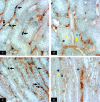Hypokalemic nephropathy is associated with impaired angiogenesis
- PMID: 18178802
- PMCID: PMC2391040
- DOI: 10.1681/ASN.2007030261
Hypokalemic nephropathy is associated with impaired angiogenesis
Abstract
Hypokalemic nephropathy is associated with alterations in intrarenal vasoactive substances, leading to vasoconstriction, salt-sensitivity, and progression of interstitial fibrosis. In this study, we investigated whether hypokalemic nephropathy might also involve impaired renal angiogenesis. Sprague-Dawley rats that were fed low-potassium diets developed peritubular capillary loss that began in the inner stripe of the outer medulla (week 2) and progressed to the outer stripe of the outer medulla (week 4) and cortex (week 12). These changes were associated with increased macrophage infiltration, increased expression of both monocyte chemoattractant protein-1 and TNF-alpha, and a loss of vascular endothelial growth factor and endothelial nitric oxide synthase. Renal thiobarbituric acid-reactive substances, markers of oxidative stress, were increased late in disease. In conclusion, hypokalemic nephropathy is associated with impaired renal angiogenesis, evidenced by progressive capillary loss, reduced endothelial cell proliferation, and loss of VEGF expression.
Figures








Similar articles
-
Impaired angiogenesis in the aging kidney: vascular endothelial growth factor and thrombospondin-1 in renal disease.Am J Kidney Dis. 2001 Mar;37(3):601-11. doi: 10.1053/ajkd.2001.22087. Am J Kidney Dis. 2001. PMID: 11228186
-
Hypokalemia induces renal injury and alterations in vasoactive mediators that favor salt sensitivity.Am J Physiol Renal Physiol. 2001 Oct;281(4):F620-9. doi: 10.1152/ajprenal.2001.281.4.F620. Am J Physiol Renal Physiol. 2001. PMID: 11553508
-
Expression of insulin-like growth factor-I and transforming growth factor-beta in hypokalemic nephropathy in the rat.Kidney Int. 2001 Jan;59(1):96-105. doi: 10.1046/j.1523-1755.2001.00470.x. Kidney Int. 2001. PMID: 11135062
-
The role of growth factors and ammonia in the genesis of hypokalemic nephropathy.J Ren Nutr. 2002 Jul;12(3):151-9. doi: 10.1053/jren.2002.33511. J Ren Nutr. 2002. PMID: 12105812 Review.
-
Longitudinal growth in chronic hypokalemic disorders.Pediatr Nephrol. 2010 Apr;25(4):733-7. doi: 10.1007/s00467-009-1330-7. Epub 2009 Nov 10. Pediatr Nephrol. 2010. PMID: 19902272 Review.
Cited by
-
The Effect of Aldosterone on Cardiorenal and Metabolic Systems.Int J Mol Sci. 2023 Mar 11;24(6):5370. doi: 10.3390/ijms24065370. Int J Mol Sci. 2023. PMID: 36982445 Free PMC article. Review.
-
A Multi-Disciplinary Approach to Managing End-Stage Renal Disease in Anorexia Nervosa: A Case Report.Clin Med Insights Case Rep. 2023 Apr 21;16:11795476231169385. doi: 10.1177/11795476231169385. eCollection 2023. Clin Med Insights Case Rep. 2023. PMID: 37113798 Free PMC article.
-
Kaliopenic nephropathy revisited.Clin Kidney J. 2016 Aug;9(4):543-6. doi: 10.1093/ckj/sfv154. Epub 2016 Mar 15. Clin Kidney J. 2016. PMID: 27478593 Free PMC article.
-
Association between Hypokalemia and Albuminuria in a Japanese General Population.Nephron. 2023;147(7):417-423. doi: 10.1159/000529424. Epub 2023 Feb 1. Nephron. 2023. PMID: 36724744 Free PMC article.
-
Severe acute kidney injury with anuria induced by hypokalemia requiring hemodialysis: a case study.BMC Nephrol. 2025 Mar 24;26(1):149. doi: 10.1186/s12882-025-03973-z. BMC Nephrol. 2025. PMID: 40128658 Free PMC article.
References
-
- Amlal H, Krane CM, Chen Q, Soleimani M: Early polyuria and urinary concentrating defect in potassium deprivation. Am J Physiol Renal Physiol 279: F655–F663, 2000 - PubMed
-
- Kimura T, Nishino T, Maruyama N, Hamano K, Kubo A, Iwano M, Shiiki H: Expression of Bcl-2 and Bax in hypokalemic nephropathy in rats. Pathobiology 69: 237–248, 2001 - PubMed
-
- Tsao T, Fawcett J, Fervenza FC, Hsu FW, Huie P, Sibley RK, Rabkin R: Expression of insulin-like growth factor-1 and transforming growth factor-beta in hypokalemic nephropathy in the rat. Kidney Int 59: 96–105, 2001 - PubMed
Publication types
MeSH terms
Substances
Grants and funding
LinkOut - more resources
Full Text Sources
Other Literature Sources
Medical
Research Materials

